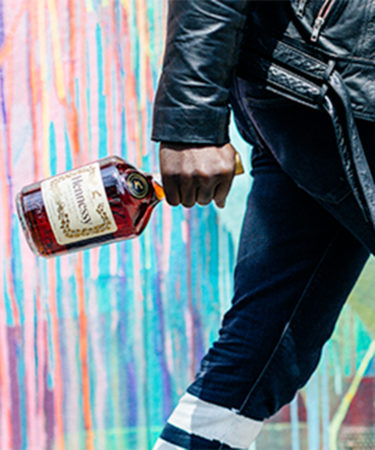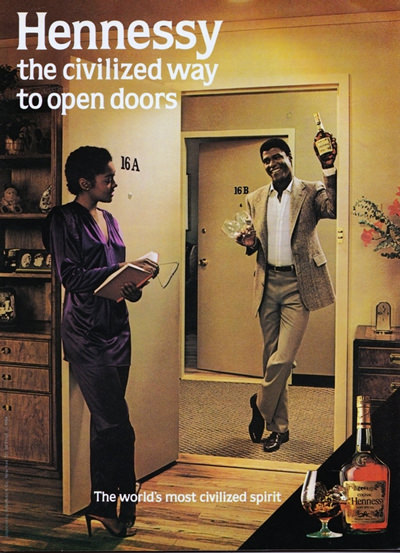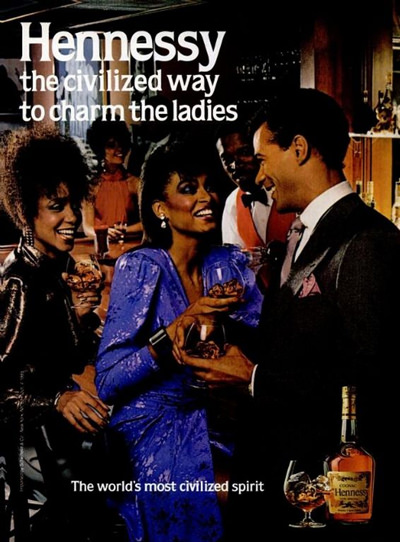“I found a picture from 10 years ago, back in college, and I had a fifth of Hennessy V.S. in my hand,” said Kevin Madden, Möet Hennessy USA’s Associate Manager of Multicultural Marketing, when asked about his first experience with cognac. When I asked him what drew him to try cognac in the first place, he described growing up witnessing his grandfather drink dark liquor, followed by the hype of hip hop lyrics that continued to heighten his interest.
If you are African American you probably have some of the same memories, like Madden and me, of attending social gatherings such as family reunion cookouts, house parties, or the annual Memorial Day white party where some guy is holding his own personal bottle of Hennessy or the table has three bottles of it on ice. Though men are typically seen drinking cognac in black culture, both men and women indulge in the beverage. And although cognac comes in a variety of options, such as Martell and Remy Martin, Hennessy beats them all out as the most consumed cognac in the American black community. Because of this, it’s become synonymous with rap music and African Americans, who are the brand’s major consumers and advocates.
As a black woman, I began to wonder where this trend came from in the first place. Many articles circulating the web mention rap artist Busta Rhyme’s song, “Pass the Courvoisier,” as the historical marker of when cognac consumption in the black community peaked. But Busta wasn’t rapping about anything new; blacks had already been “passing” cognac for decades. And that’s because Hennessy was one of the first spirit brands to authentically invest in a minority audience. Let’s take a quick look at the receipts.
The birth of Cognac originated in the southwest region of France when Dutch sailors needed ways to transport wine during long voyages. By the 18th and 19th centuries the new “burnt wine” was being exported to England, Holland, Asia, and America. According to a recent article in Slate, African Americans first documented consumption of cognac during World War II as they travelled throughout France.
Following the war, Hennessy placed advertisements in black publications — a decision that was rare given the times. “Hennessy was one of the first brands to feature an ad in the famous Ebony and Jet magazines with black models in the 1950s,” said Madden. Who knows if Hennessy was able then to predict that it was investing into an audience that Nielsen recently reported as the most brand- loyal and with a buying power of $1.2 trillion in 2015? But the strategy paid off. With an older generation of cognac drinkers, it was only a natural progression that the trend continued into the ’90s and 2000s, according to Madden.
We all know having a seat at the table is what truly matters, and Hennessy took note of that. It wasn’t just about placing ads in black neighborhoods; the company was also a leader in hiring blacks in ranks of leadership. During the height of our nation’s civil rights movement, in 1963, Hennessy brought on 1942 bronze medal Olympian Herb Douglass. He was with the company for more than three decades, serving as Vice President of Urban Market Development. Douglass was just the third African American to reach the level of vice president of a major national corporation. Now that’s a MAJOR KEY.
And then, finally, there was music. The dissemination of information by music is an aspect of black culture that stems from Western Africa and slavery. A West African ‘griot’ is a storyteller, singer, and musician. The griot, a trained orator and historian, keeps records of the village’s events, passing the stories to the next generation. During slavery, music was used to not only preserve history, as it did in West Africa, but also to send messages on how to obtain freedom. The words in songs matter and the word Hennessy or cognac is mentioned in over 1,000 songs by such famed artists as Notorious BIG, 2Pac, Kanye West, Rick Ross, Nas, Dr. Dre, and 50 Cent. You can’t buy that kind of product placement or endorsement.
In 1992 the infamous rapper 2Pac had an entire song dedicated to and entitled “Hennessy.” Even this summer, rapper Drake’s hit “One Dance” mentions the power Hennessy has on him. “Hip hop artists are trendsetters,” said Trey Poindexter, a 22 Media LLC marketing consultant for Bacardi. “People who listen to hip hop are attracted to glamorous parts of the artists’ lifestyle and liquor is a part of that.” And Hennessy continued to innovate, observing the influence that hip-hop artists had over their audiences and embracing it. To celebrate its 250th anniversary in 2015, Hennessy marked the milestone by naming legendary hip-hop artist Nas as brand ambassador.
During the early 2000s, America’s black community grew 35 percent faster than the country’s population in its entirety. According to Poindexter, the strategic endorsement from a hip hop artist or song mention can translate into higher sales for companies. Rappers and their lyrics have become a key marketing strategy for targeting mainstream America. In 1997 rapper LL Cool J was featured in a Gap commercial and in 2003 rapper Pusha T wrote McDonald’s famous “I’m Lovin’ It” jingle. Advertising CEO Steve Stoute describes the phenomenon in his book “The Tanning of America: How Hip Hop Created a Culture That Rewrote the Rules of the New Economy.” According to Stoute, the urban culture icons grab the attention of a diverse millennial generation that essentially grew up on hip hop.
In 2020 the buying power of the black community will reach over $1.4 trillion. Let me say that again, $1.4 trillion. That is more than what Canada has in national debt. With college enrollment increasing, the average salary growing, and the average age decreasing, the black community ultimately influences popular culture, setting trends. Any brand that does not consider this audience doesn’t want to be great. And trust me, it is going to take more than just slapping a black model standing in the back of an ad for a company to become a “go to” staple brand for black America. Brands are going to have to be authentic. They’re going to have to follow Hennessy’s lead.


